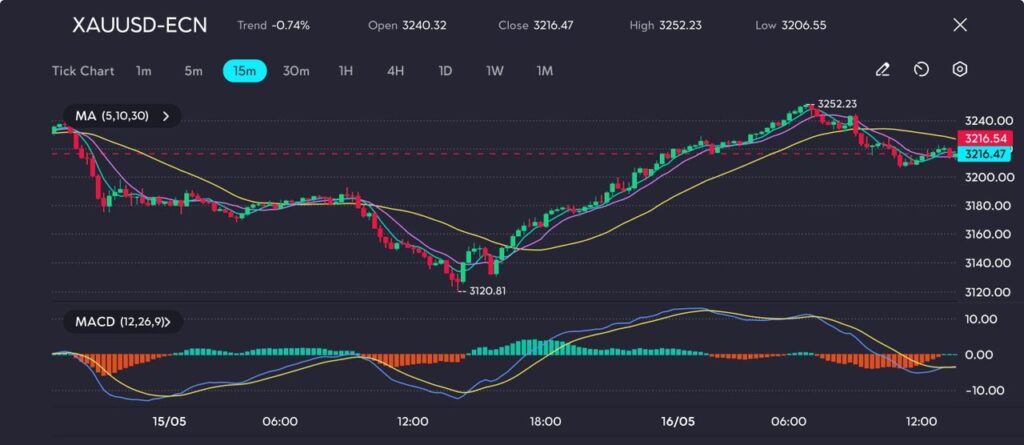Australia’s Trade Minister hesitant to join the US in trade conflict with China
Gold prices surged significantly due to weak US data, geopolitical tensions, and declining yields.
Market Response to Economic Data
The market quickly reacted, with fixed-income sectors adjusting to expectations of Federal Reserve interest rate cuts in 2025. Ongoing political tensions between Russia and Ukraine also fueled gold’s price increase. From a technical perspective, gold could face a drop if it cannot stay above $3,200. A close above $3,257 may support an upward trend, but falling below $3,200 could see prices drop to $3,100. Central banks continue to buy gold, viewing it as a safe investment and a hedge against inflation. Gold prices are affected by geopolitical instability and changes in the US Dollar, showing an inverse relationship with US Treasuries and other risk assets. Gold’s rise to $3,228, recovering from a dip to $3,120, showed a weekly 1.40% gain in response to new US economic data. The surprising -0.5% drop in the PPI for April contrasted with a slight 0.1% increase in retail sales for the same month. Weekly jobless claims remained unchanged at 229,000, matching expectations. Together, these factors weakened the US Dollar and lowered bond yields, leading investors to rethink interest rate forecasts. Quickly adjusting, fixed-income markets began pushing back expectations for Federal Reserve rate cuts to 2025. Lower yields on US Treasuries and a softer dollar made gold more attractive, especially due to rising geopolitical tensions in Eastern Europe.Technical Perspective on Gold Price Levels
Technically, gold is nearing a critical point. The $3,200 level is crucial for short-term trends. Staying above this level could lead to more upward movement. If gold can close above $3,257, it may unlock further gains. Conversely, if it cannot hold above $3,200, drops as low as $3,100 could occur, where previous buyers have shown interest. Another important aspect affecting gold demand is central bank activity. These institutions continue to accumulate gold, reinforcing its status as a defensive investment during times of uncertainty with fiat currencies or inflation. Their buying creates long-term support, separate from speculative influences. It’s also important to note the relationship between gold, the US Dollar, and Treasury yields. When yields drop—often due to expectations of a less active central bank—gold tends to benefit. Additionally, if the dollar weakens, as it did after the recent PPI announcement, gold typically rises. Sustained political tensions often increase the demand for gold as a store of value. A more unstable geopolitical situation could lead to greater defensive asset positioning, resulting in higher prices for safe-haven investments like gold, which carries less counterparty risk. As the market adjusts to potential shifts in policy, and with real yields reacting to short-term data, we can expect sharp responses to even minor data releases. Weekly updates on inflation or employment may lead to noticeable changes in expectations and prices for rate-sensitive assets. Staying flexible and attentive to key technical and macroeconomic levels will be crucial during this potentially volatile time. Tracking price movements above or below key thresholds will likely influence short-term strategies in the coming quarter. Create your live VT Markets account and start trading now.Gold Softens As Diplomatic Progress Dents Safe-Haven Appeal

Gold prices slipped to $3,216 per ounce on Friday, pressured by diminished demand for safe-haven assets as global sentiment improved in response to several diplomatic advances. The precious metal is heading for a weekly decline of over 3%, having retreated from an earlier session high of $3,252.23.
The principal catalyst for the pullback was a temporary thaw in trade relations between the United States and China, with both nations agreeing to suspend tariffs for 90 days. This gesture eased investor concerns over the potential economic fallout from extended protectionist policies, at least in the near term.
Other geopolitical flashpoints appear to be stabilising, adding to the pressure. A ceasefire between India and Pakistan remains intact, and although peace negotiations between Russia and Ukraine have stalled, they have not sparked renewed flight-to-safety behaviour in the markets.
Nonetheless, the macroeconomic backdrop remains broadly supportive of gold. Recent US inflation data came in softer than expected, strengthening the case for the Federal Reserve to commence interest rate reductions, potentially twice before the year’s end. Markets are currently factoring in 50 basis points in rate cuts, possibly starting as early as July.
However, Federal Reserve Chair Jerome Powell urged caution in his latest remarks, warning that inflation may become increasingly erratic due to continued supply-side disruptions. This uncertainty could make it more difficult for central banks to maintain price stability and, in turn, renew investor interest in gold as a hedge against monetary policy volatility.
Technical Analysis
Gold prices initially extended their rebound, surging from a session low of 3120.81 to test resistance at 3252.23 before retreating. The strong upside move was supported by a bullish MACD crossover and upward momentum through the 5-, 10-, and 30-period moving averages on the 15-minute chart. However, the rally lost steam just below the 3260 mark, where sellers re-entered the market.

Following the peak, bearish pressure set in, sending gold back below the 30-period MA and prompting a corrective pullback toward the 3215 area. The MACD histogram has flattened, and the signal lines are converging, suggesting the rally may be pausing. Immediate support lies around 3206, while resistance remains firm near 3250. A break below 3200 could open the door to 3180, whereas a bullish resurgence above 3252 would revalidate the uptrend.
Cautious Outlook
In the short term, gold may struggle to regain its upward momentum amid improving risk appetite and subdued inflationary pressures. That said, lingering geopolitical uncertainties and evolving monetary policy expectations continue to provide underlying support. Any setbacks in trade discussions or renewed volatility in inflation could revive demand for gold as a defensive asset, with the $3,160 level likely to act as a key floor.
Create your live VT Markets account and start trading now.




